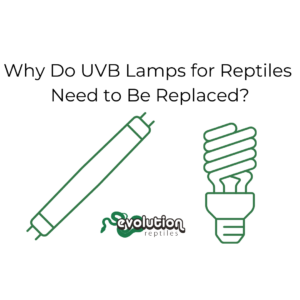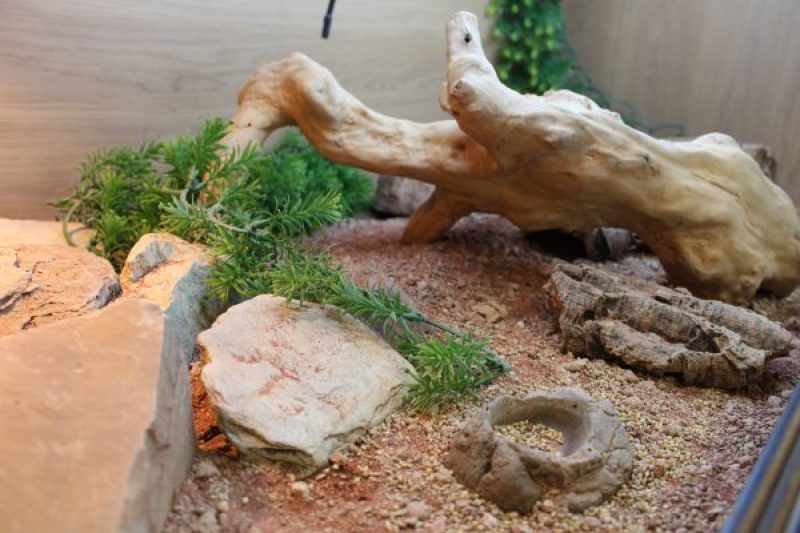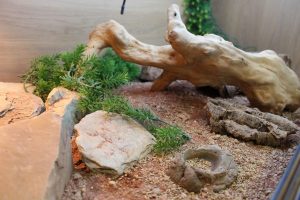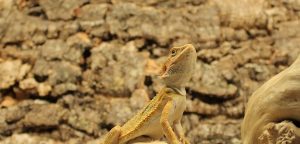
Why Do UVB Lamps for Reptiles Need to Be Replaced?
Why Do UVB Lamps for Reptiles Need to Be Replaced and How Often UVB lamps are essential for the health and well-being of reptiles, but

If you’ve never decorated a bearded dragon vivarium before it can seem to be a rather daunting task – there’s all that space, and should you use rocks or branches, and what about substrate…?
Don’t panic, let the staff at Evolution Reptiles help you out!
Before you start, think about what you need and why. That’s a really good guide, and so is considering where the animal comes from in the first place. The regions of Australia where you find bearded dragons are characterised by dry, open scrub, lots of rocks, and bare, gravelly soil. So providing the sort of rainforest vivarium you would give to a water dragon isn’t going to do your beardie any good at all!
So let’s break this down into its components.

The stuff on the floor! Now, this can be rather a thorny subject; there are many, many groups on the internet that scream about how dangerous loose substrates are, and you should never use them if you care about your beardie and so on and so forth. Now they are not, as it happens, entirely wrong: certainly, the only way to be absolutely certain that your dragon never, ever ingests substrate is to take it away completely.
However. If you have the correct temperatures, the correct UV exposure and the correct diet and supplementation, then your dragon is not going to eat substrate in the first place! Please read our guide Impaction – What’s The Real Story?
Our opinion is that any minor risk is more than offset by the environmental enrichment provided by allowing your dragon to dig about, and rearrange its living space. Some dragons appear to very much enjoy flinging their substrate around, and for females it can be vital if they decide they need somewhere to lay their eggs.
There are several options here:
Tiles/cage carpet – we don’t like them, but they’re a perfectly valid way to keep your dragon. Wash cage carpet daily, and make sure to scrub the viv floor underneath. Some people use a half and half approach, which does work well with tiles – half tile, half substrate. Honestly? It’s easier just to place a rock under the basking light.
Wood chip – we use beech chip regularly for our babies and for our boarders. It isn’t particularly natural, but it does give the dragon good traction, they can rearrange it to their heart’s content, and it doesn’t make a hideous grinding noise when it gets stuck in the runners of the door. It’s very easy to spot pick and does a good job of helping to keep odour to a minimum.
Sand – always a contentious choice, depending on which internet group you belong to! In our (extensive) experience sand is absolutely fine as a substrate PROVIDED that your temperatures are correct, your UV is strong, your basking area is bright and your supplementation regime is suitably varied. If that is correct, then sand is a suitable choice if your beardie likes it. Calcium sand comes in lots of bright colours, but is no good as a supplement of its own. Sand is not terribly natural for them in and of itself, and if it’s layered too deep it can get rather smelly between clean outs. Plus, sand makes the most hideous squealing noise when it gets stuck in the runners of the vivarium doors!
Soil – there are several of the soil based mixtures available these days, designed with certain species in mind and they’re all excellent. They are much more natural than any of the others, and can be very easy to spot pick and keep clean. They can be heavy to transport, and sometimes get a little dusty when they dry out. Available in several different colours and grades.
Rocks – a good pile of rocks is a delight for a bearded dragon, but be careful. Any rocks used should be placed on the floor of the vivarium before the substrate is put in; the last thing you want is for the dragon to dig underneath and have the rock fall on them. So pack the substrate around the rock, it’s much safer! Also, piles of rocks look fabulous, but stick them together with aquarium grade silicone first. Beardies love to investigate and to push things around, and a rockslide won’t do them any good at all. A good slab of slate or lava rock directly under the basking light gives a marvellous platform for your dragon to warm up on; it holds the heat after lights out, and generally is a very natural way for your dragon to thermoregulate.
Branches – dragons do love to climb! They don’t need the dizzying arboreal heights of the chameleons or the water dragons, but they do love to be able to explore their surroundings three dimensionally. It’s more that they are built to climb over, rather than climb up! So any branches used must be well anchored – or propped – and sturdy enough to bear the weight of your dragon. A good solid java branch makes a wonderful sleeping or basking platform, and a large piece of cork bark is great to add interest to your bearded dragon vivarium.
Hides – a hide isn’t, strictly speaking, necessary, but your dragon will very much appreciate being able to get out of everyone’s line of sight from time to time. They are simple creatures, and seem to think that if they can’t see you then you can’t see them – so as long as they can get their head and part of the body hidden they don’t bother with the rest of them. A large rock, or a branch laid on the floor can work just as well as a hide that your dragon can get all the way under. In fact it can be more beneficial, as the dragon is still getting exposed to its UV while its hiding.
Greenery/plants – dragons appear to thoroughly enjoy dragging their decor about, pulling it off the walls and generally trashing it. Their rather robust interactions with their environment mean that any fake greenery you use must be non toxic and fit for purpose; it is always tempting to go with the fake plants that are sold in certain bargain stores, as they do appear to be very similar. However, there is always the chance that the materials used to make them are not safe – they’re not tested as being safe for reptiles, because that’s not what they’re designed for! Are you willing to risk your pet’s health? We don’t think it’s worth it.
Look at the environment as a whole. You have a warm end and a cool end, a hot spot and an open area for the dragon to run around in. Don’t just think of it as flat ground; add a little height with branches for the dragon to explore, or a large bunch of artificial plants for him to climb or hide in.
Once you have decided which substrate to use then decide if you would like to use a rock or a branch for a basking platform. Not too high – you don’t want your dragon to be able to touch his basking bulb! Make it easy to climb, as your dragon will be scrambling up it in the morning, when he’s a little cooler and a bit more sluggish.
So you have your basking platform. What next? When we’re decorating a new bearded dragon vivarium, we tend to add in the branches at this point. We try and make sure that the dragons have access to several different levels, plus by using several branches you can lock them together in such a way that they cannot fall over and injure your pet. Hides or flatter branches can be laid along the substrate as this point.
Now you have a basking area, and a framework of branches. Make sure you’ve left enough room for food and water bowls.
This is the point at which you add the fake greenery. The more the merrier, especially for a very young dragon; they can hide in amongst the leaves, which will help their confidence, and when they’re small they can use them to climb on as well. As they get older and heavier this is less possible, although they do appear to enjoy rustling around in them – and, as mentioned earlier, pulling them off the walls!
A quick word here about bio active systems. We’re huge fans of bio active; if you’ve visited the shop you will have seen our planted tanks and how happy and relaxed their inhabitants are. Yes, you can keep arid habitat species such as bearded dragons on bio active but it isn’t something we have done ourselves – yet. It’s far too large a subject for this article, but rest assured we will be exploring the subject in more depth at some point in the future.
Now is the time to double check your temperatures, and when you’re satisfied, put your dragon in his or her new home and enjoy watching them explore it!
Click here to view the Vivexotic Repti-Home AAL Bearded Dragon Vivarium for sale, or view our bearded dragon vivarium set up here.

Why Do UVB Lamps for Reptiles Need to Be Replaced and How Often UVB lamps are essential for the health and well-being of reptiles, but

Why Reptiles Require UVB Light and How Their Bodies Use It Reptiles, unlike mammals, cannot synthesize vitamin D3 through their diet alone. Instead, they rely

How to Care for Your Reptile During a Power Cut Power cuts can be stressful, especially when you have a reptile that relies on a
Copyright 2021 Evolution Reptiles
All rights reserved.